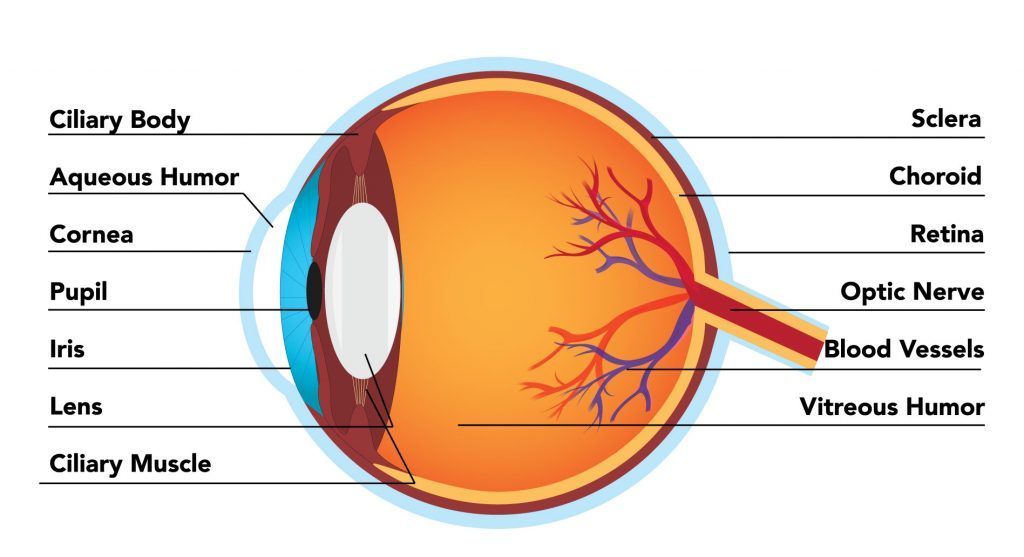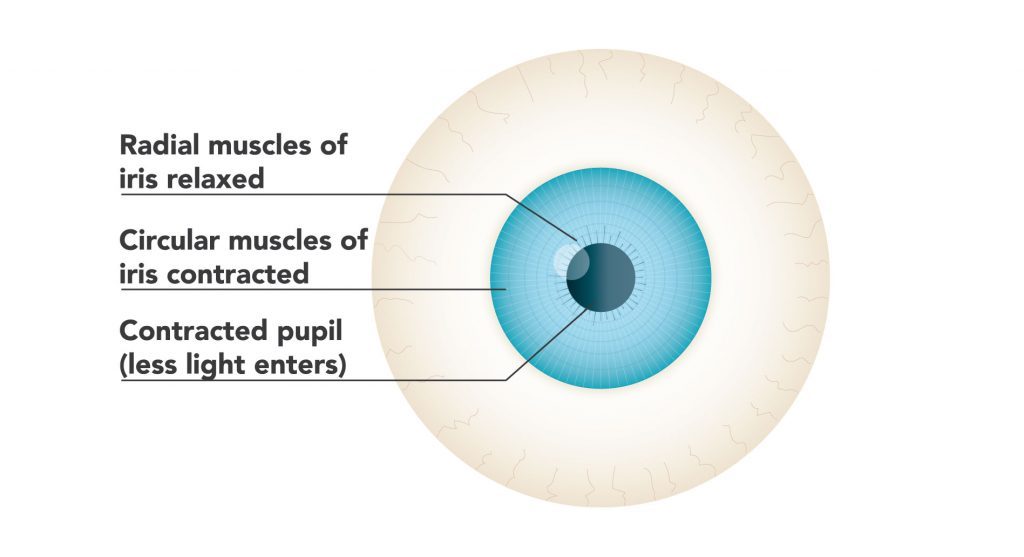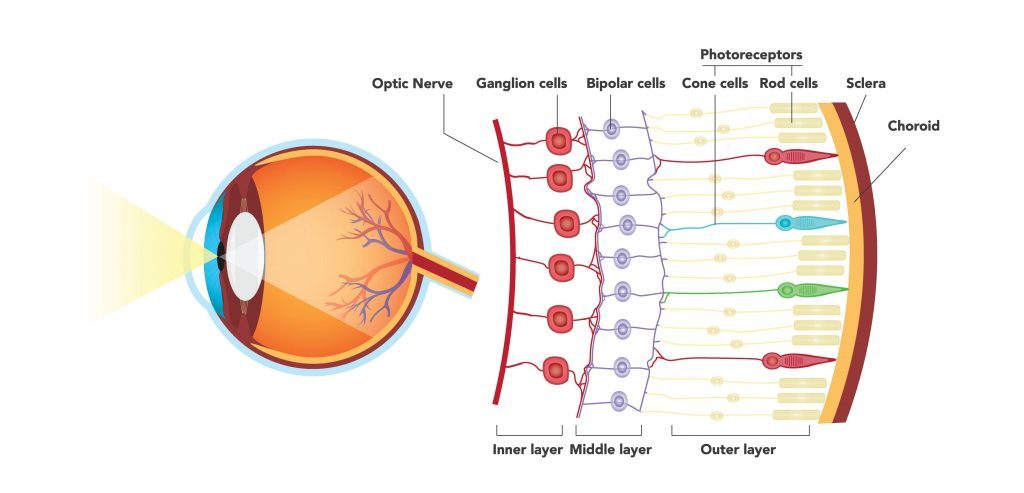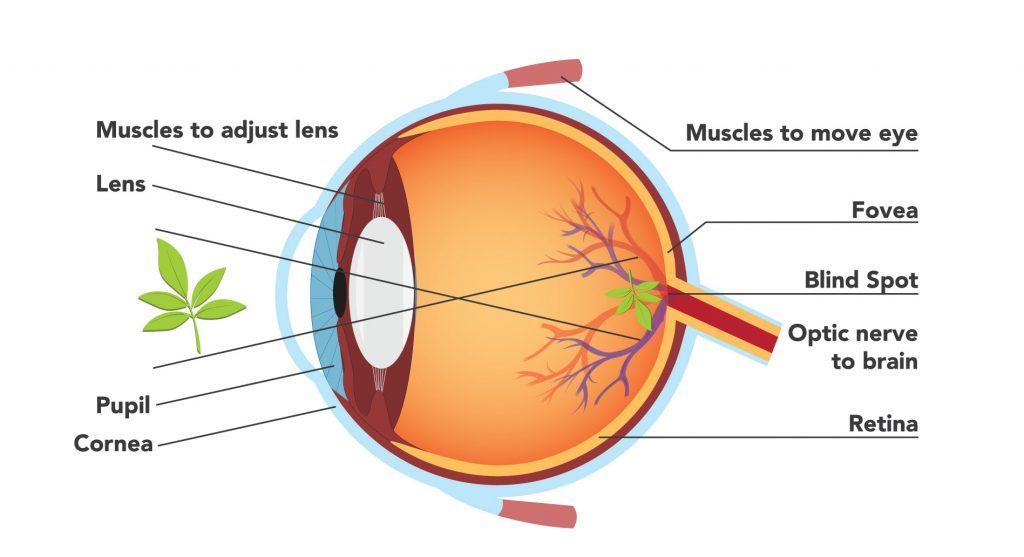- 08008 20 20 80
Menu
Menu
The eye is one of the most impressive organs in the body and the feat of human sight is something that shaped our evolution as a species.
Welcome to the ultimate guide to sight and common sight problems.
In the eyeball, there are multiple parts that make sight possible. Here we take a look at some of the main structures within the eye that enable sight.

| Main Eye Structures | Description |
| Ciliary Body | The ciliary body is an extension of the iris and produces the fluid in the eye |
| Aqueous Humor | The liquid that sits in a chamber behind the cornea. |
| Cornea | Acts as a window at the front of the eye. |
| Pupil | The pupil sits in the middle of the Iris which controls the amount of light that enters the eye. |
| Iris | The coloured part of the eye. |
| Lens | A clear disc-like structure that helps to focus light on the retina. |
| Ciliary Muscle | The ciliary muscle controls the shape of the lens, so that we can see elements that are near and far away. |
| Sclera | The sclera is the white part of the eye and protects everything inside |
| Choroid | The choroid is a layer of the eye that lies between the retina and the sclera. It is made up of layers of blood vessels that nourish the back of the eye. |
| Retina | The retina is a light-sensitive part inside the inner layer of the eye. Its job is to turn light into signals about images that the brain can understand. |
| Optic Nerve | The optic nerve delivers messages from the retina to the brain. |
| Vitrous Humor | The vitreous humor is the clear gel that fills the space between the lens and the retina |
Now that you’re familiar with the major parts of the eye, find out how they come together to perform the miracle of sight.
Vision occurs when the brain interprets light that is reflected from an object.
The light enters the cornea through the pupil. The pupil is comprised of two types of muscular fibers. When exposed to light, the circular fibers contract and the radial fibers relax. When there is less light, the radial fibers contract and the circular relax.

The cornea (the transparent part in front of your pupil) causes the light rays to refract. This causes the image to partially focus. The light rays continue through the lens, which focuses the rays even more by changing shape.
This change is actually carried out by the ciliary muscle. With faraway objects, the ring of ciliary muscle relaxes causing ligaments to pull on the lens. This movement causes the lens to become thinner and flatter. With nearby objects the ciliary muscle contracts. The ligaments stop pulling and the lens returns to its natural shape.
The light rays cross the inside of the eye and reach the retina or inner lining of the eye that converts light into nerve impulses. The retina contains two types of cells. Rods handle vision in low light. They see only in black and white. Cones handle colour vision and detail.

The retina produces an inverted image of the object that is sent to the brain by the optic nerve. The brain processes the information and constructs an image of the object, and vision is the term for the process of seeing this object.

There’s a lot to learn when it comes to the eye. Here are a few interesting facts about your eyes and eyesight.
Did you know:
With such a complex structure, the eye can experience a number of problems and disorders that affect your ability to see.
Causes for these disorders range from ageing to infection to damage to the eye’s structure or nerves.
Below are the top 10 most common eye disorders, along with information about their causes and treatment.
Taking care of your eyes is the best way to prolong your eye health and maintain your sight.
Below are a few ways you can take better care of your eyes.
Take your contacts out before you shower, swim, or otherwise get water on your face. Not doing so could end up damaging your contact lenses and, more importantly, your eyes. Bacterial buildup behind the contact lens has, in extreme cases, led to parasitic infections.
Wear safety glasses when you do any home improvement projects—even with simple stuff.
See an eye doctor at least every two years, or more frequently if you have high blood pressure, high cholesterol, or diabetes. Many eye conditions are contingent on having other conditions, so make sure you pay close attention to your ocular health if you have diabetes, high cholesterol or high blood pressure.
Wear your sunglasses – yes, even when it’s cloudy or cold! It may seem counterintuitive, but the right colour of sunglass lens can in fact improve your vision. They not only combat glare but also reduce UV light rays, which can damage the eyes in the long term and impact vision.
Take regular breaks from the computer. Your mum might have told you that your eyes would turn square from too much telly. She wasn’t wrong about long-time screen exposure being damaging, although it’s not square eyes you need to worry about. Prolonged screen time can lead to eye dryness, irritation , eye fatigue, blurred vision, and in extreme cases, myopia.
Quit smoking. While the impact of smoking on lung disease has been known for some time, recent research shows that smoking increases the risk of age-related macular degeneration, cataracts , glaucoma and diabetic retinopathy. Also, you don’t look cool.
© 2019 Laser Vision Scotland. All rights reserved.